This post may contain affiliate links. Read our disclosure policy.
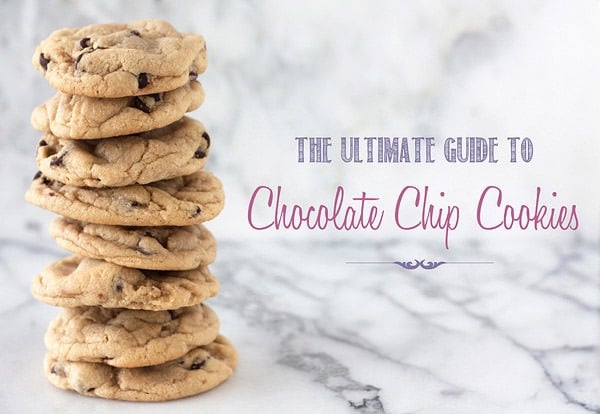
In this post I’m going to share with you how various ingredients and techniques can affect the taste, texture, and appearance of your chocolate chip cookies. This will hopefully help you understand how a Chocolate Chip Cookie Recipe works so you can make the PERFECT batch every time, whatever you consider to be perfect. This information will allow you to alter or create your own chocolate chip recipe that produces cookies just the way YOU like them. You’ll be an expert on the anatomy of the chocolate chip cookie.
I used the Nestle Tollhouse Chocolate Chip Cookie recipe as my control and made little changes and variations in techniques and ingredients to show you how they affect the cookie.
I halved and adapted the original Tollhouse recipe. I kept everything the same through each recipe test, changing just one key thing to see its effect and photographing the results for you.
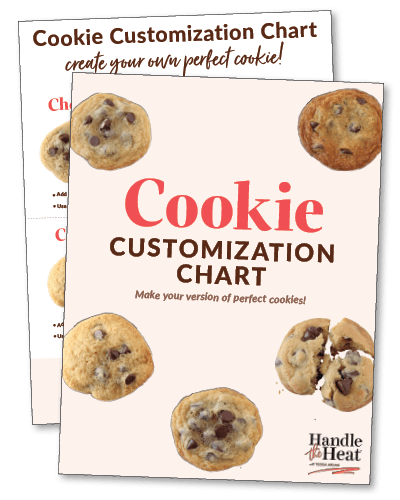
Struggling with Flat or Dry Cookies?
My free guide shows you how to fix texture problems and bake cookies you’ll love.
Cookie Tools and Ingredients Used:
Tools and Ingredients Used (when applicable):
-Spring-Loaded Cookie Scoop (Medium or 1 1/2-Tablespoon size)
–Chicago Metallic sheet pans
–Escali Digital Food Scale
–KitchenAid 5-quart Stand Mixer
–Oven thermometer
–Unbleached parchment paper
-Gold Medal All-Purpose Flour
-Fine sea salt
-Light brown sugar
-Large eggs
-Unsalted butter at a cool room temperature
Control Recipe
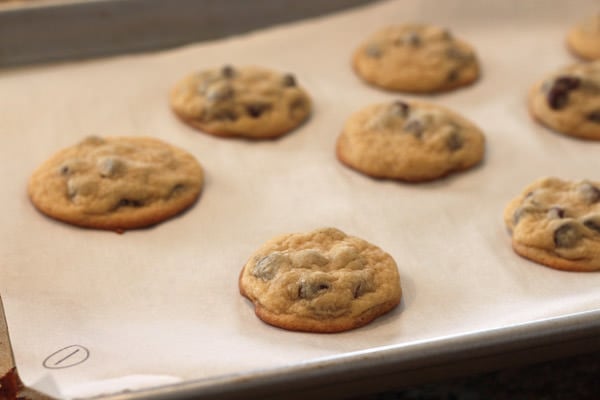
Ingredients:
1 cup plus 2 tablespoons (142 grams) all-purpose flour
1/2 teaspoon baking soda
1/2 teaspoon salt
1 stick (113 grams) unsalted butter, at room temperature
1/4 cup plus 2 tablespoons (75 grams) granulated sugar
1/4 cup plus 2 tablespoons (75 grams) packed light brown sugar
1/2 teaspoon vanilla
1 large egg
1 cup (170 grams) semi sweet chocolate chips
Directions:
Preheat oven to 350°F. Line baking sheets with nonstick baking mats or parchment paper.
In a medium bowl combine the flour, baking soda, and salt.
In the bowl of an electric mixer beat the butter, granulated sugar, and brown sugar until creamy, about 2 minutes. Add the egg and vanilla, beating well to combine. Gradually beat in the flour mixture. Stir in the chocolate chips. Scoop 1 1/2 tablespoon-sized balls and place onto prepared baking sheets.
Bake for 9 to 11 minutes, or until golden brown. Cool for 2 minutes before removing to wire racks to cool completely.
Here is the control, an adapted version of the Nestle Tollhouse recipe. The full recipe I used to base all of the tweaks on is at the bottom of this post.
Baking Powder:
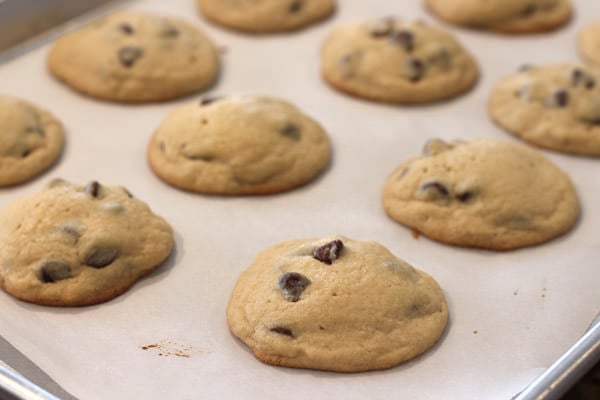
Removed baking soda from recipe and used 1/2 teaspoon baking powder. This produced results that were more cakey and puffed while baking.
Baking Powder AND Baking Soda:
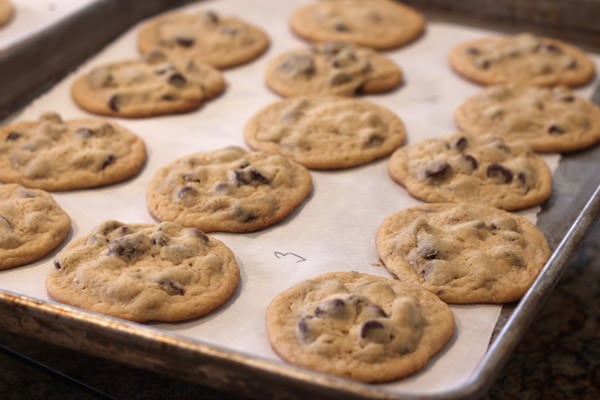
Used 1/4 teaspoon baking powder and 1/4 teaspoon baking soda. This produced results that were crisp at the edges, soft in the middle, with a good amount of spread. The combination of the two leaveners produced the best results in my opinion.
MORE Flour:
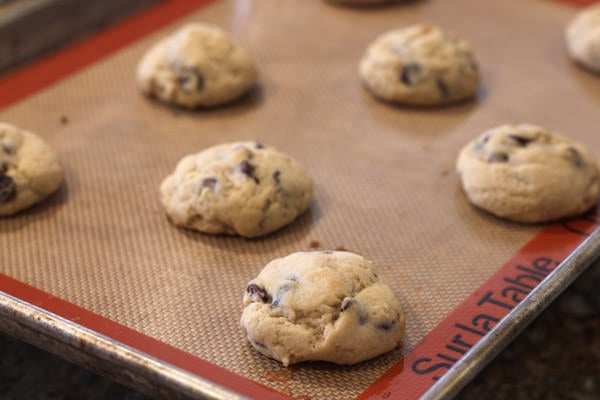
Increased the flour to 2 cups (250 grams) which created a more crumbly dough and very little spread. The cookies were small yet thick and relatively undercooked (ooey and gooey) in the middle.
MELTED Butter:
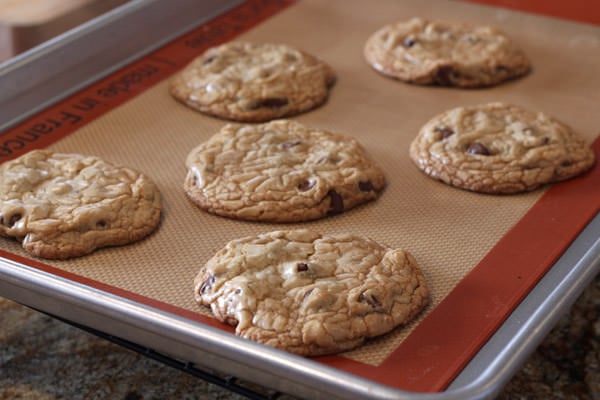
I replaced the room temperature butter with melted and cooled butter. Instead of creaming the butter and sugar with an electric mixer, I simply stirred the butter and sugars together then let sit for 5 minutes, until the sugar was better absorbed by the butter. This produced flatter cookies that had a shiny, crackled top reminiscent of brownies. They were also more crisp at the edges.
All Granulated Sugar:
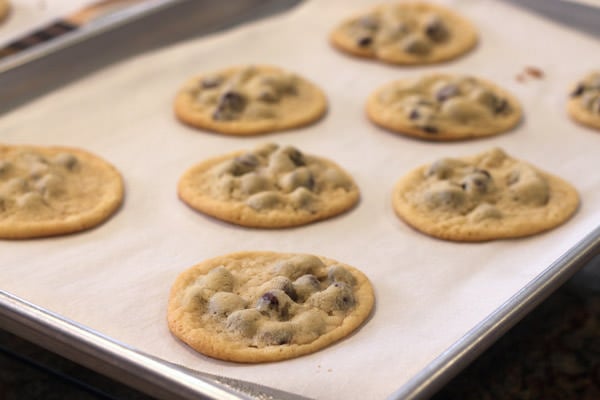
I used 3/4 cup granulated sugar (150 grams) in this recipe which produced flat, white, chewy, and slightly crunchy cookies but with little flavor. Since baking soda (called for in the control recipe) requires an acid (such as brown sugar) to react, these cookies fell very flat as you can see by the way the chocolate chips protrude.
All Brown Sugar:
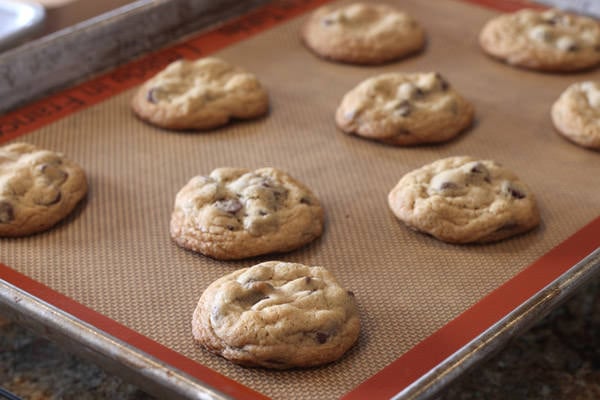
I used 3/4 cup (150 grams) packed light brown sugar in this recipe which produced thick, brown, and soft cookies with an intense butterscotch flavor. The original control recipe uses an even ratio of granulated and brown sugars. If you prefer your cookies to be flatter, chewier, or crisper, use more granulated sugar. If you prefer your cookies to be softer and thicker and have a pronounced butterscotch flavor, use more brown sugar.
24-hour CHILLED Dough:
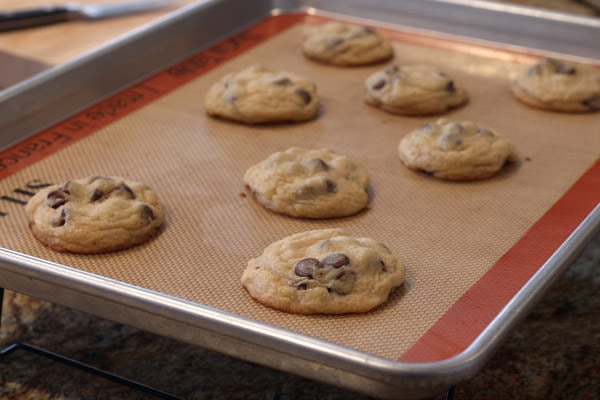
I used the control recipe but chilled it in the fridge for about 24 hours before shaping and baking. This produced cookies that were slightly thicker, chewier, darker, and with a better depth of butterscotch flavor. If you have time, try chilling your next cookie dough for at least 24 hours, or up to 48 hours.
Final Comparison:
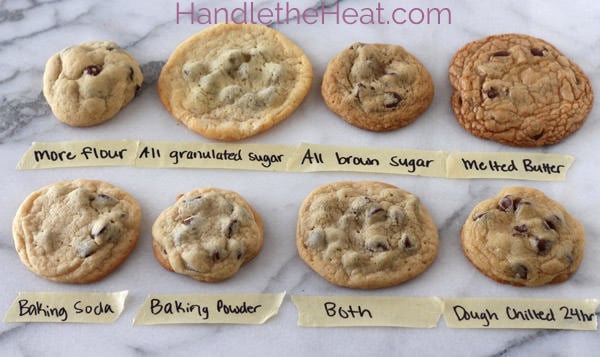
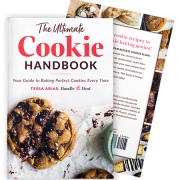
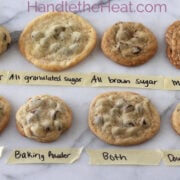
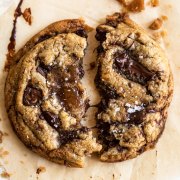
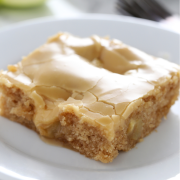
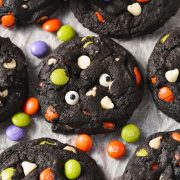
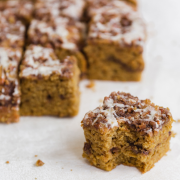
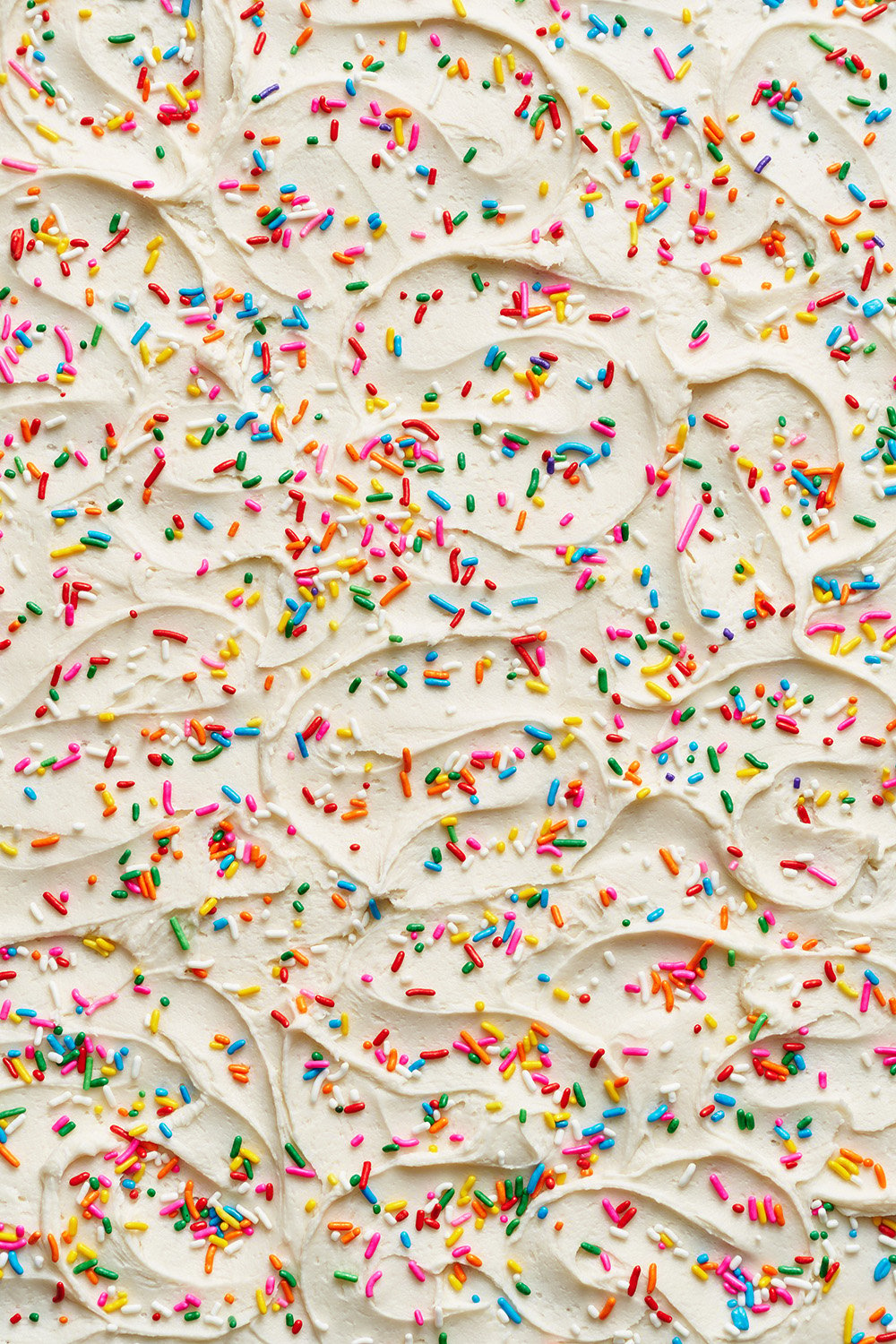
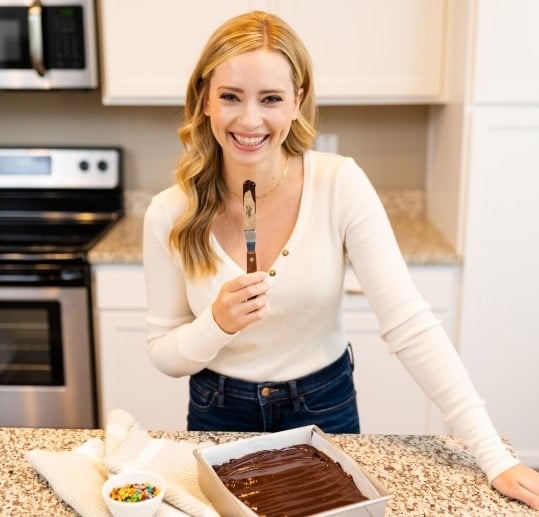

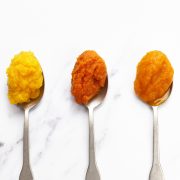
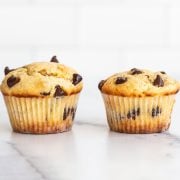
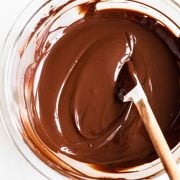









I’m curious if you have experimented with chocolate chip cookie cakes. Which recipe alterations would work best for that application?
I have a batch of dough in my fridge right now,. Excited about baking them tomorrow!
I’m not sure what you mean… there’s no real way to turn a cookie recipe into a cake recipe so maybe I’m misunderstanding you? Happy baking!
This has been so very helpful…..I’m so glad you posted the pictures, it’s so easy to pick out what my cookies look like and why. I too have pretty much always used the Toll House recipe with a few changes & still never been perfectly happy with the results…..now I’m going to try a few of your suggestions. I’m pretty sure my family is going to go for more or all brown sugar, both baking soda & baking powder and going to try the cornstarch tip. Everyone has been so helpful with their comments & tips……
Thanks for a great site
I know I am repeating what everybody has already said so I won’t be long winded. THANK YOU! This is one of the most useful posts I have ever come across. I am kind of a snob when it comes to chocolat chip cookies, I know how I like them and that Is how I want them to be. Now, I know!!!!!!!!!!!!!!!
Thank you – I’m so glad you enjoyed the post!!
I tried the baking soda and baking powder combination and here are my results:
He cookies are completely delicious but just the slightest bit dry. They didn’t really turn out like they did in the picture (here’s a picture of mine: http://imgur.com/Im09ocz) but maybe that’s because I didn’t cook them on parchment paper. Unless you have something better, I definitely recommend this recipe and I’m so glad I found this guide to the perfect cookie!
I’m glad you found it helpful. Thanks so much for including a picture, it makes it so much easier to offer suggestions. Looking at it, the cookies seem unusually pale (do they appear that way in person?) so my first thought is that your baking soda may actually be expired. Baking soda promotes browning. To test for freshness, place 1/4 teaspoon in a bowl and pour 1 teaspoon distilled vinegar on top. If it bubbles up, it is fresh. If nothing happens, throw away. Another question pops in my mind when looking at the pic – did you use an electric mixer to beat the dough? It looks as though the dough may not have been totally cohesive before being baked, if that makes sense. If you were following the Nestle Tollhouse recipe base, the cookies should definitely not be dry. Is is possible the flour was mis-measured? I actually find that recipe on the greasy side!
A year late but just saw a friend post this and I love it as a guide! Often wondered about baking soda v. baking powder and glad it’s confirmed that brown sugar is a must!
I had an older lady in the market tell me
she only uses shortening and never butter but I have not tried it.
HI, Not sure if this has been brought to your attention. In the control recipe Ingredients “1 cup plus 2 tablespoons (5 ounces or 142 grams) all-purpose flour” . Should it be 1 cup plus 2 tablespoons (9 ounces) or 1/2 cup plus 2 tablespoons (5 ounces or 142 grams) all-purpose flour.
Thank you for an interesting article. I’ll try some of your hints. I Haven’t been able to make a great chocolate chip cookie since they took the animal fats out of Crisco in the ’90s.
Hi Bonnie – thanks for your comment but it looks like you are mistaken. 1 cup of flour usually equals about 4.5 ounces (depending on the brand). I have a post about measuring that details flour volumes here: https://handletheheat.com/2014/07/ultimate-guide-measuring.html
And here are two additional resources: http://www.kingarthurflour.com/recipe/master-weight-chart.html
http://www.traditionaloven.com/conversions_of_measures/flour_volume_weight.html
I’d be curious to see what you think of the results of using your preferred version and 1) adding an extra egg, and 2) using soft margarine.
Hi! I actually created my version of the ultimate chocolate chip cookie based off these experiments: https://handletheheat.com/ultimate-chocolate-chip-cookies/ (it has an extra egg yolk!)
Wow, this is very helpful. You should try this with varied cooking temperature. I always cook my cakes and cookies at 300. Cookies and cakes stay moist and don’t get crispy. My gingerbread cookies are soft and people always want the secret recipe 🙂
Thanks for the tip! I actually experimented a bit with baking temperatures in part 4: https://handletheheat.com/ultimate-guide-chocolate-chip-cookies-part-4/
Hi! One thing I haven’t seen mentioned is that flours are regional and variations in cookies might also be the results of different flour brands. I used a special type for baking that I learned from my commercial baker mother-in-law, I forgot the name today, but will repost when I find the paper I wrote it on. There are so many different types of wheat that produce different results in baking.
Hi Kerry, that’s a great point! I made an effort to include the brand of flour used so the results could be better replicated. To be honest, I haven’t noticed a huge different in the outcome of cookies using different AP flours (King Arthur vs. Gold Medal, etc.) but have noticed more of a difference in other baked goods like cakes. I typically use bread flour anyways which has a more standard protein content!
Thank you SO much for this… it is very helpful!
Does these techniques work for (basically) any cookie with the usage of brown & white sugars?
They should work for the most part!